A Brief History
Early Years:
William De Vescy was made Justiciary of Ireland in 1290 and, in the same year, he gave the Carmelites in Ireland a friary at Kildare. The De Vesy family, who held vast tracts of land in both England and Ireland, already had links with the Carmelite Order through their endowment of one of the first Carmelite foundations in England, at Hulne in Northumberland in 1242. The friary at Kildare was dedicated to the Blessed Virgin Mary. The presence of the Carmelites and the Franciscans in the town is referred to in the late thirteenth century poem ‘The land of Cockayne’:
There is a right fair abbey
Both of white monks and of grey.
The popular name for the Carmelite friary over the years has been White Abbey.
The formation of an independent Irish Province was finally agreed at the English Province Chapter held in London in 1305. A native of Kildare and a distinguished member of the Carmelite community there, David O’Buge, was strongly opposed to this separation from the English Province. For his defiance, O’Buge was sent to lecture in theology at the Carmelite house of studies in Trier in Germany. David O’Buge had studied at Oxford University and earned a Doctorate in Theology. He has been described as philosopher, preacher, theologian, and was skilled in both civil and canon law. Church and State sought his advice. Despite his earlier stance, David was Provincial of the Irish Province from 1320-1327. He died in Kildare and was laid to rest there.
Another outstanding member of the Kildare community around this time was Ralph Kelly, who became Procurator General of the Order, the first Irishman to hold this office. He had studied civil and canon law at Avignon in France. Ralph was appointed Archbishop of Cashel in 1346. He was considered an excellent preacher and administrator.
Around this time there was a school of some distinction attached to the Kildare friary. This was probably due to the influence of the learned David O’Buge. However, prayer, preaching, the celebration of the sacraments, and encouraging devotion to Our Lady of Mount Carmel, including the wearing of the Brown Scapular, would have constituted the main ministry of the Carmelites in Kildare and, indeed, wherever they had a community.
Suppression and Conflicts:
In the early stages of the Geraldine revolt against King Henry VIII in 1534, some of the silver and gold plate from Maynooth Castle was sent for safekeeping to the Carmelites in Kildare. Friars in general were considered hostile to the King at the time.
The friary was surrendered by the Prior to the officials of the King on April 3rd 1539. The Carmelites did not have a house in Kildare again until the mid-eighteenth century. It was then a small presence, one or two friars. A chapel was erected close to the pre-Reformation site. This remained in use until the present church was completed in 1887.
A Fr William Duane of the Carmelite friary died on April 24th 1790. It would appear that two Carmelite friars became caught up in the fallout from 1798 Rebellion around Kildare. Fr Farrell was murdered in the massacre at Gibbet Rath. The uninscribed stone near the Rath possibly marks his grave. There is an oral tradition that the Prior, Fr Raney, was left for dead by yeomen in the backyard of the friary but was saved by the intervention of the housekeeper.
Rebuilding:
Fr Michael Hughes was associated with White Abbey for many years, serving as Prior for over fifteen years. He died on March 25th 1847. There was a successful Classical school attached to the friary, from sometime after 1829 until 1889. By 1889 the De La Salle Order, dedicated to education, had established its school in the town. The Carmelites continued their pastoral ministry. Many people came long distances, from Wicklow and Laois, in devotion to Our Lady of Mount Carmel and to be enrolled in the Brown Scapular.
Fr Staples was Prior during the building of the church between 1884 and 1880. He travelled to the United States to raise funds for its completion. The foundation stone of the present church was laid on the 8th of December, 1884. The architect was William Hague who designed churches in the Pugin style. The church is therefore gothic in design and the builder was John Harris of Monasterevan, who used Wicklow granite and local stone from Boston, Rathangan.
The church is cruciform in plan with the nave being set off with alternating window and arched roof-truss. The transepts are defined by polished granite pillars with moulded bases and carved caps which support arches in line with the walls of the nave. The side chapels are seen from the transepts and chancel through arches springing from moulded piers which also support the large chancel arch with its polished granite corbel shafts, moulded bases and carved caps.
The principal entrance doorway faces east with pillared jambs, carved tympanum and moulded arches set in a projecting porch. The tower, with its lantern belfry, extends above the level of the nave roof. It has deeply recessed windows on each face and is finished with a moulded cornice. From this point the tapering spire rises to a height of 140 feet and is surmounted by a cross.
On the north transept wall of the church are inserted – for safe keeping – some interesting fifteenth/sixteenth century stone sculptures which came from the ruins of the pre-Reformation Franciscan Grey Abbey. They are similar to the carvings from Great Connell and Dunfierth, also in Co Kildare, and probably came from the same workshop.
The stained glass in the church includes scenes from the lives of Our Lord and the Blessed Virgin Mary, from the Scapular Vision, as well as Saints Patrick and Brigid, and the four Evangelists. The rose window over the main entrance is of special interest with its centre piece being the Prophet Elijah, the spiritual founder of the Order. The surrounding panels show St Telesphorus, St Dionysius, St Albert (Patriarch of Jerusalem), St Andrew Corsini, St Cyril of Alexandria, St Louis IX, St Angelus, and St Albert of Sicily.
Present Day:
Traditionally, the role of a country friary is to administer to the spiritual needs of the local community. This is done through the celebration of Mass, hearing confessions, visiting the sick, spiritual direction and social care. Throughout the 19th and 20th century, White Abbey, Kildare, has been a fine example of this. This commitment to the local community has been reciprocated through the support which the friary has been given consistently by the people of the town and surrounding areas. White Abbey is not just a physical landmark but also a cultural and spiritual one in the life of the town.
On April 10th, 2016, White Abbey was entrusted to the care of the Carmelite Delegation of St. Thérèse and St. Albert (India), The Delegation were formally entrusted with keeping the rich heritage and tradition of White Abbey alive and fresh into the future. The friars have been welcomed by the people of the town and surrounding areas.


